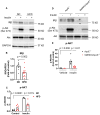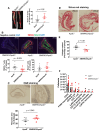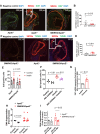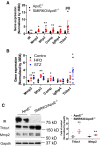Insulin receptors in vascular smooth muscle cells regulate plaque stability of atherosclerosis
- PMID: 39197028
- PMCID: PMC11646105
- DOI: 10.1093/cvr/cvae193
Insulin receptors in vascular smooth muscle cells regulate plaque stability of atherosclerosis
Abstract
Aims: Increased prevalence of acute myocardial infarction related to diabetes and insulin resistance is associated with an elevated risk of unstable atherosclerotic plaques, which are characterized by reduced vascular smooth muscle cells (VSMCs) and extracellular matrix (ECM) and increased inflammation. Thus, insulin resistance may reduce plaque stability, as deleting insulin receptors (IRs) in VSMCs decreases their proliferation and enhances apoptosis.
Methods and results: Direct effects of insulin on VSMCs to alter plaque composition were studied using mice with double knockout of ApoE and IR genes in VSMCs with SMIRKO/ApoE-/-, Myh11-CreERT2EYFP+/ApoE-/-, and Myh11-CreERT2EYFP+IRKO/ApoE-/- mice, which were also used for lineage tracing studies. Compared with ApoE-/- mice, SMIRKO/ApoE-/- mice exhibited more atherosclerotic plaques, which contained less VSMCs and collagen but increased levels of VSMC apoptosis and necrotic areas. Lineage tracing studies showed that Icam1+ Vcam1+ VSMC was inflammatory, which increased in the aortas of Myh11-CreERT2EYFP+IRKO/ApoE-/- mice compared with control mice. Isolated VSMCs lacking IRs expressed higher inflammatory cytokines than cells with IRs. Cell-based studies indicated that insulin's anti-apoptotic and pro-proliferative effects in VSMCs were mediated via activation of the IR/Akt pathway, which were decreased in VSMCs from SMIRKO or high-fat diet mice. An analysis of the IR targets that regulated inflammatory cytokines in VSMCs showed that thrombospondin 1 (Thbs1) and Mmp2 were consistently increased with a loss of IRs. Insulin inhibited Thbs1 expression, but not Mmp2 expression, through p-Akt/p-FoxO1 pathways in VSMCs from ApoE-/- mice, and was impaired in cells from SMIRKO/ApoE-/- mice. Thbs1 further induced Icam1 and Mmp2 expressions in VSMCs.
Conclusion: Insulin via IRs has significant actions in VSMCs to decrease inflammation, apoptosis, and ECM turnover via the activation of Akt and FoxO1 pathways. The inhibition of insulin actions and related pathways related to insulin resistance and diabetes may contribute to the formation of unstable atherosclerotic plaques.
Keywords: Atherosclerosis; Insulin receptor; Smooth muscle cells; Thrombospondin 1.
© The Author(s) 2024. Published by Oxford University Press on behalf of the European Society of Cardiology. All rights reserved. For commercial re-use, please contact reprints@oup.com for reprints and translation rights for reprints. All other permissions can be obtained through our RightsLink service via the Permissions link on the article page on our site—for further information please contact journals.permissions@oup.com.
Conflict of interest statement
Conflict of interest: none declared.
Figures








References
-
- Rawshani A, Rawshani A, Franzen S, Eliasson B, Svensson AM, Miftaraj M, McGuire DK, Sattar N, Rosengren A, Gudbjornsdottir S. Mortality and cardiovascular disease in type 1 and type 2 diabetes. N Engl J Med 2017;376:1407–1418. - PubMed
-
- Burke AP, Kolodgie FD, Zieske A, Fowler DR, Weber DK, Varghese PJ, Farb A, Virmani R. Morphologic findings of coronary atherosclerotic plaques in diabetics: a postmortem study. Arterioscler Thromb Vasc Biol 2004;24:1266–1271. - PubMed
-
- Virmani R, Burke AP, Kolodgie FD, Farb A. Vulnerable plaque: the pathology of unstable coronary lesions. J Interv Cardiol 2002;15:439–446. - PubMed
-
- Howard G, O'Leary DH, Zaccaro D, Haffner S, Rewers M, Hamman R, Selby JV, Saad MF, Savage P, Bergman R. Insulin sensitivity and atherosclerosis. The Insulin Resistance Atherosclerosis Study (IRAS) Investigators. Circulation 1996;93:1809–1817. - PubMed
-
- Bonora E, Kiechl S, Willeit J, Oberhollenzer F, Egger G, Meigs JB, Bonadonna RC, Muggeo M. Insulin resistance as estimated by homeostasis model assessment predicts incident symptomatic cardiovascular disease in Caucasian subjects from the general population: the Bruneck study. Diabetes Care 2007;30:318–324. - PubMed
Publication types
MeSH terms
Substances
Grants and funding
LinkOut - more resources
Full Text Sources
Medical
Research Materials
Miscellaneous

